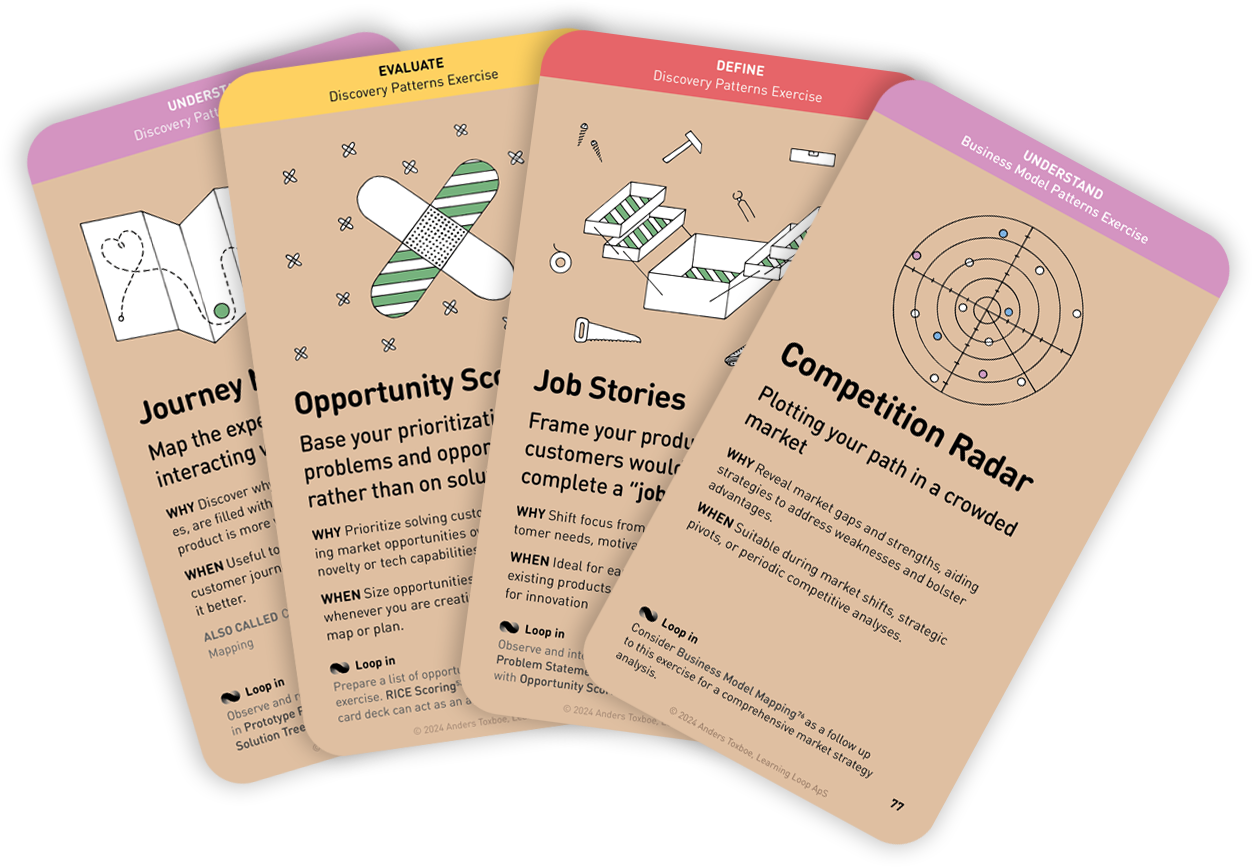Workshop Exercises: Evaluate
Persuasive Patterns Impact Mapping
Select persuasive techniques for maximum impact and feasibility

Why: Evidence-based decisions on how to influence user behavior has a larger chance of success
When: Apply when you have a list of ideas on how to influence user behavior ready for evaluation
To aid the goal of not just launching a feature or intervention, but to drive meaningful change in user behavior that aligns with business objectives, Impact Mapping can help facilitate that progress.
The core purpose of Impact Mapping is to ensure that every initiative undertaken is justified in terms of the value it adds towards reaching a goal. Rather than starting with solutions or features and working backwards, Impact Mapping starts with the end goal and works forwards, asking what impacts need to be created to achieve that goal and what behaviors (from users or team members) will lead to those impacts.
In the context of behavioral design, this technique helps to avoid the common pitfall of implementing interventions that are well-intentioned but ultimately disconnected from the actual needs and motivations of users. By focusing on impacts, teams are compelled to think deeply about the real-world effects their designs will have on user behavior. It shifts the conversation from “What can we build?” to “What should we achieve, and how can our users’ behaviors lead us there?”
Impact Mapping is a collaborative process that brings together multiple perspectives, ensuring that decisions are informed by a comprehensive understanding of the user and the business. It encourages teams to consider the various actors who will influence or be influenced by the new behaviors—the users, the staff, perhaps even broader stakeholders in the community. By doing so, it paints a clear picture of who needs to be involved and how they contribute to the success of the initiative.
By aligning deliverables with goals through their impacts and actors, Impact Mapping helps teams prioritize their efforts and resources on high-value activities. It acts as a guardrail against the drift that can occur when projects become feature-driven rather than goal-driven, ensuring that every design decision and behavioral nudge is purposefully steering users towards outcomes that benefit both them and the organization.
Instructions for running this play
Before the exercise: Articulating the existing design goal. This should be a concise sentence focusing on the problem to solve and the target audience.
- Restate the design goal
Lead a discussion to ensure clarity and collective understanding of the goal. - Define and discuss target audience
Let the group identify the target audience and discuss their specific needs and contexts. - Identify Human Values
Using a provided list of human values, each participant individually selects values they believe are most relevant to the target audience. The list below is a good starting point:
| Health | Physical, psychological, and material well-being. |
| Ownership | Right to possess and control objects or information. |
| Privacy | Freedom from disturbance and control over personal info. |
| Equality | Equal treatment regardless of individual or group differences. |
| Trust | Confidence in reliability and vulnerability of others. |
| Autonomy | Ability to make independent decisions and actions. |
| Transparency | Openness and clear communication in agreements. |
| Responsibility | Accountability and decision-making capability. |
| Respect | Considerate and polite treatment of others. |
| Identity | Self-understanding and acceptance of personal change. |
| Safety | State of psychological peace and composure. |
| Longevity | Sustaining ecosystems for present and future needs. |
- Discuss and decide on values
The group discusses their choices, aiming to reach a consensus on a set of key human values that align with both the audience’s needs and the company’s ethos. Together, the team narrows down the list to 2-3 core human values and discusses what each value means in the context of their target audience. - Phrase a Human Design Goal
Participants revisit the initial design goal and compare it with the selected human values. Rewrite the design goal collaboratively, integrating the chosen values. The aim is to ensure that the revised goal reflects both the business objectives and the human values. - Discuss future impact
Discussion on how this Human Design Goal will guide future design decisions and ensure they are ethically aligned and user-centered.
Use the Human Design Goal as a reference throughout the design process to ensure alignment with human values.
Tips to perfect this play
Master and adapt the play to fit your context and needs.
Tip: Ground Decisions in Evidence-Based Practices
Encourage participants to use research and data as the foundation for discussions and decisions. This approach promotes objectivity and aligns solutions with proven outcomes, ensuring that ideas are not solely based on assumptions or personal opinions. This mirrors the paper’s use of behavior change theory and evidence to guide the intervention design.
Tip: Promote consensus and collective ownership
Foster a collaborative environment where participants feel ownership over the decisions made during the workshop. Aim for consensus on key points, such as the target audience, key values, and design goals, to ensure everyone feels aligned and committed to the next steps.
Tip: Reflect on ethical considerations
Encourage participants to reflect not just on the business or technical outcomes, but also on the ethical and societal implications of their designs. This is in line with the paper’s broader focus on reducing unnecessary imaging, ensuring that designs align with both user needs and broader ethical concerns.
Tip: Reflect on Ethical Considerations
Encourage participants to reflect not just on the business or technical outcomes, but also on the ethical and societal implications of their designs. This is in line with the paper’s broader focus on reducing unnecessary imaging, ensuring that designs align with both user needs and broader ethical concerns.
A collection of workshop exercises that will help you ditch dull meetings and facilitate with confidence. It will help you master the design process and have more productive time with your team. The card deck will be ready for purchase in the end of 2026 and is now undergoing rigorous testing.
Reserve your deck!Related plays
- Jenkins, H. J., Moloney, N. A., French, S. D., Maher, C. G., Dear, B. F., Magnussen, J. S., & Hancock, M. J. (2018). Using behaviour change theory and preliminary testing to develop an implementation intervention to reduce imaging for low back pain. BMC Health Services Research, 18(1), 734.

